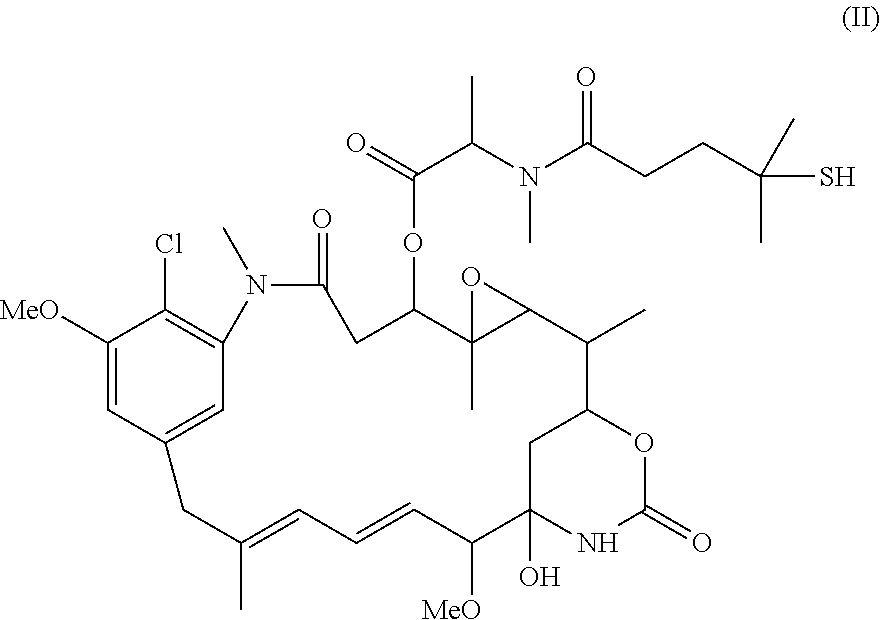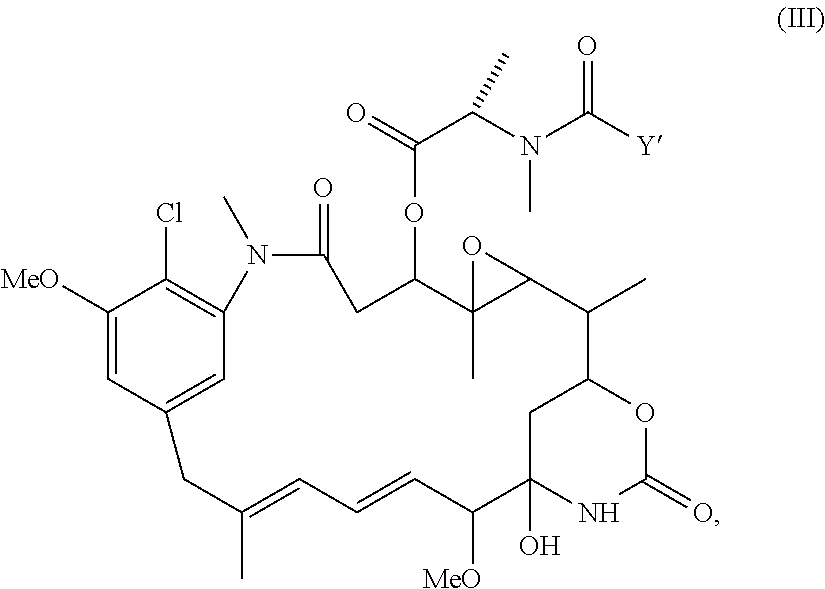Use of n-hydroxysuccinimide to improve conjugate stability
a technology of n-hydroxysuccinimide and conjugate stability, which is applied in the direction of antibody medical ingredients, drug compositions, peptides, etc., can solve the problems of unstable ester bonding, limited current process, slow release of drug from conjugate, etc., and achieve the effect of improving stability
- Summary
- Abstract
- Description
- Claims
- Application Information
AI Technical Summary
Benefits of technology
Problems solved by technology
Method used
Image
Examples
example 1
[0096]This example demonstrates the beneficial effect of adding N-hydroxysuccinimide (NHS) during the modification reaction of a process for preparing a cell-binding agent-cytotoxic agent conjugate. In particular, this example demonstrates that the addition of NHS to the modification reaction has a beneficial effect on the stability of an antibody-maytansinoid conjugate.
[0097]Humanized huN901 antibody was reacted with the heterobifunctional crosslinking reagent SMCC and the maytansinoid DM1 using a previously described process (see, e.g., U.S. Pat. No. 5,208,020 and U.S. Patent Application Publication No. 2006 / 0182750), with or without exogenous NHS added to the modification reaction, in order to make a conjugate with a maytansinoid to antibody ratio (MAR), also known as drug to antibody ratio, of approximately 3.0.
[0098]For the previously described process, huN901 (18 mg / mL) first was reacted with SMCC (5.0 fold molar excess relative to the amount of antibody) to form the modified ...
example 2
[0107]This example demonstrates the beneficial effect of adding N-hydroxysuccinimide (NHS) during the conjugation reaction of a process for preparing a cell-binding agent-cytotoxic agent conjugate. In particular, this example demonstrates that the addition of NHS to the conjugation reaction has a beneficial effect on the stability of an antibody-maytansinoid conjugate.
[0108]Humanized huN901 antibody was reacted with the heterobifunctional crosslinking reagent SMCC and the maytansinoid DM1 using a previously described process (see, e.g., U.S. Pat. No. 5,208,020 and U.S. Patent Application Publication No. 2006 / 0182750), with or without exogenous N-hydroxysuccinimide (NHS) added into the conjugation reaction, in order to make a conjugate with a maytansinoid to antibody ratio (MAR), also known as drug to antibody ratio, of approximately 3.0.
[0109]For this study, huN901 (18 mg / mL) was reacted with SMCC (5.0 fold molar excess relative to the amount of antibody) to form the modified antibo...
example 3
[0113]This example demonstrates the beneficial effect of adding N-hydroxysuccinimide (NHS) to the holding step of a process for preparing a cell-binding agent-cytotoxic agent conjugate. In particular, this example demonstrates that incubating an antibody-maytansinoid conjugate in the presence of exogenous NHS after the conjugation reaction has a beneficial effect on the stability of the antibody-maytansinoid conjugate.
[0114]Humanized huN901 antibody was reacted with the heterobifunctional crosslinking reagent SMCC and the maytansinoid DM1, using a previously described process (see, e.g., U.S. Pat. No. 5,208,020 and U.S. Patent Application Publication No. 2006 / 0182750), with or without exogenous NHS added to the holding step following purification of the conjugation reaction, in order to make a conjugate with a maytansinoid to antibody ratio (MAR), also known as drug to antibody ratio, of approximately 3.0. The purified conjugate was held at different pH values in the absence or pres...
PUM
| Property | Measurement | Unit |
|---|---|---|
| molar ratio | aaaaa | aaaaa |
| time | aaaaa | aaaaa |
| temperature | aaaaa | aaaaa |
Abstract
Description
Claims
Application Information
 Login to View More
Login to View More - R&D
- Intellectual Property
- Life Sciences
- Materials
- Tech Scout
- Unparalleled Data Quality
- Higher Quality Content
- 60% Fewer Hallucinations
Browse by: Latest US Patents, China's latest patents, Technical Efficacy Thesaurus, Application Domain, Technology Topic, Popular Technical Reports.
© 2025 PatSnap. All rights reserved.Legal|Privacy policy|Modern Slavery Act Transparency Statement|Sitemap|About US| Contact US: help@patsnap.com



